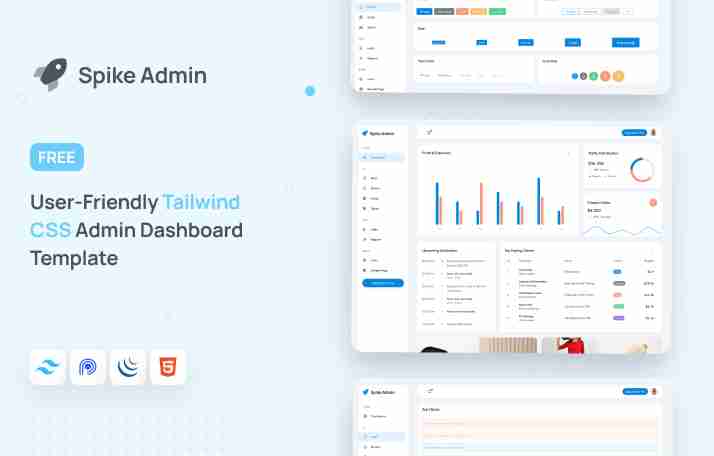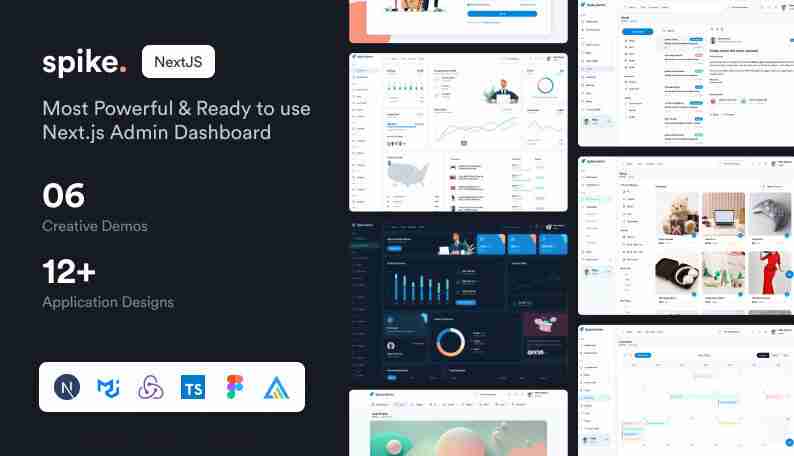 Web Front-end
Web Front-end
 JS Tutorial
JS Tutorial
 Integrating Tailwind CSS with Other Frontend Frameworks for Admin Panels
Integrating Tailwind CSS with Other Frontend Frameworks for Admin Panels
Integrating Tailwind CSS with Other Frontend Frameworks for Admin Panels
Dec 07, 2024 am 05:59 AMAdmin panels are essential tools for managing and analyzing data efficiently in modern web applications. Tailwind CSS, a highly customizable utility-first CSS framework, is rapidly becoming the go-to choice for creating clean and responsive interfaces. By combining Tailwind CSS with frameworks like React, Angular, Vue.js, and Next.js, developers can build powerful and visually stunning admin panels. In this blog, we’ll explore the benefits of integrating Tailwind CSS admin templates with other frontend frameworks, along with a showcase of some popular templates.
Why Use Tailwind CSS for Admin Panels?
1. Customization Flexibility
Tailwind CSS allows developers to define custom themes and styles directly in their projects. This flexibility makes it easy to match the branding and design requirements of an admin panel.
2. Predefined Utility Classes
With a rich library of utility classes, Tailwind CSS eliminates the need to write repetitive CSS, enabling faster development.
3. Responsive Design
Tailwind CSS simplifies responsive design with built-in classes for different screen sizes, ensuring admin panels look great on any device.
4. Integration Compatibility
Tailwind CSS can be integrated seamlessly with modern frontend frameworks, making it a versatile choice for building dynamic and interactive admin panels.
Integrating Tailwind CSS with Frontend Frameworks
1. React and Tailwind CSS
React’s component-based architecture pairs well with Tailwind CSS. Using libraries like Create React App or Next.js, developers can quickly set up projects with Tailwind’s utility-first styling.
-
Recommended Template:
Flexy React Material Dashboard
 Demo Link
Demo Link
2. Angular and Tailwind CSS
Angular’s robust framework combined with Tailwind CSS can produce highly interactive admin panels. Tailwind can be integrated into Angular CLI projects for seamless styling.
-
Recommended Template:
MaterialPro Angular Dashboard
 Demo Link
Demo Link
3. Vue.js and Tailwind CSS
Vue.js provides simplicity and flexibility, making it ideal for projects using Tailwind CSS. Developers can quickly create scalable admin panels with minimal boilerplate code.
-
Recommended Template:
Spike Vue.js Admin Template
 Demo Link
Demo Link
4. Next.js and Tailwind CSS
Next.js offers server-side rendering and static site generation capabilities, making it an excellent choice for Tailwind CSS admin panels that prioritize performance.
-
Recommended Template:
MaterialPro Next.js Admin Dashboard
 Demo Link
Demo Link
5. Nuxt.js and Tailwind CSS
For Vue-based SSR projects, Nuxt.js works seamlessly with Tailwind CSS to deliver feature-rich admin panels.
-
Recommended Template:
Spike Nuxt.js Admin Template
 Demo Link
Demo Link
Free and Premium Tailwind CSS Admin Templates
Free Options
- Spike Free Tailwind Admin Template

Demo Link
-
Flexy Free Next.js Admin Template
 Demo Link
Demo Link
Premium Options
Spike Next.js Admin Template

Demo LinkFlexy Bootstrap Admin Template

Demo Link
Conclusion
Integrating Tailwind CSS admin templates with popular frameworks like React, Angular, Vue.js, Next.js, and Nuxt.js can significantly enhance the development process. Whether you’re creating a dynamic dashboard for data analysis or a sleek admin panel for backend management, Tailwind CSS provides the tools and flexibility to build a feature-rich interface.
Looking for ready-to-use templates? Check out platforms like WrapPixel for an extensive collection of free and premium Tailwind CSS admin templates tailored to your needs.
Explore More Templates:
For a broader selection of templates, visit WrapPixel or AdminMart.
The above is the detailed content of Integrating Tailwind CSS with Other Frontend Frameworks for Admin Panels. For more information, please follow other related articles on the PHP Chinese website!

Hot AI Tools

Undress AI Tool
Undress images for free

Undresser.AI Undress
AI-powered app for creating realistic nude photos

AI Clothes Remover
Online AI tool for removing clothes from photos.

Clothoff.io
AI clothes remover

Video Face Swap
Swap faces in any video effortlessly with our completely free AI face swap tool!

Hot Article

Hot Tools

Notepad++7.3.1
Easy-to-use and free code editor

SublimeText3 Chinese version
Chinese version, very easy to use

Zend Studio 13.0.1
Powerful PHP integrated development environment

Dreamweaver CS6
Visual web development tools

SublimeText3 Mac version
God-level code editing software (SublimeText3)

Hot Topics
 Which Comment Symbols to Use in JavaScript: A Clear Explanation
Jun 12, 2025 am 10:27 AM
Which Comment Symbols to Use in JavaScript: A Clear Explanation
Jun 12, 2025 am 10:27 AM
In JavaScript, choosing a single-line comment (//) or a multi-line comment (//) depends on the purpose and project requirements of the comment: 1. Use single-line comments for quick and inline interpretation; 2. Use multi-line comments for detailed documentation; 3. Maintain the consistency of the comment style; 4. Avoid over-annotation; 5. Ensure that the comments are updated synchronously with the code. Choosing the right annotation style can help improve the readability and maintainability of your code.
 Java vs. JavaScript: Clearing Up the Confusion
Jun 20, 2025 am 12:27 AM
Java vs. JavaScript: Clearing Up the Confusion
Jun 20, 2025 am 12:27 AM
Java and JavaScript are different programming languages, each suitable for different application scenarios. Java is used for large enterprise and mobile application development, while JavaScript is mainly used for web page development.
 Mastering JavaScript Comments: A Comprehensive Guide
Jun 14, 2025 am 12:11 AM
Mastering JavaScript Comments: A Comprehensive Guide
Jun 14, 2025 am 12:11 AM
CommentsarecrucialinJavaScriptformaintainingclarityandfosteringcollaboration.1)Theyhelpindebugging,onboarding,andunderstandingcodeevolution.2)Usesingle-linecommentsforquickexplanationsandmulti-linecommentsfordetaileddescriptions.3)Bestpracticesinclud
 Javascript Comments: short explanation
Jun 19, 2025 am 12:40 AM
Javascript Comments: short explanation
Jun 19, 2025 am 12:40 AM
JavaScriptcommentsareessentialformaintaining,reading,andguidingcodeexecution.1)Single-linecommentsareusedforquickexplanations.2)Multi-linecommentsexplaincomplexlogicorprovidedetaileddocumentation.3)Inlinecommentsclarifyspecificpartsofcode.Bestpractic
 JavaScript Data Types: A Deep Dive
Jun 13, 2025 am 12:10 AM
JavaScript Data Types: A Deep Dive
Jun 13, 2025 am 12:10 AM
JavaScripthasseveralprimitivedatatypes:Number,String,Boolean,Undefined,Null,Symbol,andBigInt,andnon-primitivetypeslikeObjectandArray.Understandingtheseiscrucialforwritingefficient,bug-freecode:1)Numberusesa64-bitformat,leadingtofloating-pointissuesli
 JavaScript vs. Java: A Comprehensive Comparison for Developers
Jun 20, 2025 am 12:21 AM
JavaScript vs. Java: A Comprehensive Comparison for Developers
Jun 20, 2025 am 12:21 AM
JavaScriptispreferredforwebdevelopment,whileJavaisbetterforlarge-scalebackendsystemsandAndroidapps.1)JavaScriptexcelsincreatinginteractivewebexperienceswithitsdynamicnatureandDOMmanipulation.2)Javaoffersstrongtypingandobject-orientedfeatures,idealfor
 How to work with dates and times in js?
Jul 01, 2025 am 01:27 AM
How to work with dates and times in js?
Jul 01, 2025 am 01:27 AM
The following points should be noted when processing dates and time in JavaScript: 1. There are many ways to create Date objects. It is recommended to use ISO format strings to ensure compatibility; 2. Get and set time information can be obtained and set methods, and note that the month starts from 0; 3. Manually formatting dates requires strings, and third-party libraries can also be used; 4. It is recommended to use libraries that support time zones, such as Luxon. Mastering these key points can effectively avoid common mistakes.
 JavaScript: Exploring Data Types for Efficient Coding
Jun 20, 2025 am 12:46 AM
JavaScript: Exploring Data Types for Efficient Coding
Jun 20, 2025 am 12:46 AM
JavaScripthassevenfundamentaldatatypes:number,string,boolean,undefined,null,object,andsymbol.1)Numbersuseadouble-precisionformat,usefulforwidevaluerangesbutbecautiouswithfloating-pointarithmetic.2)Stringsareimmutable,useefficientconcatenationmethodsf



 Demo Link
Demo Link
 Demo Link
Demo Link
 Demo Link
Demo Link
 Demo Link
Demo Link
 Demo Link
Demo Link
 Demo Link
Demo Link




